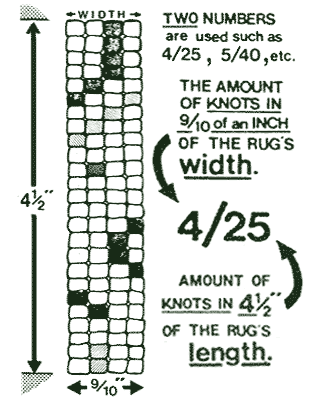RUG GUIDE
Rug Introduction 
The Illustrated Rug 
From Sheep To Rug 
Rug & Knot Types 
Rug Loom Types 
Basic Rug Care 
Stain Removal Guide 
Decorating Ideas 
Purchasing Guide 
Rug Names & Places 
Rug History Chart 
Glossary of Terms 
Presented by NEJAD RUGS:
About Oriental Rug Construction
| |||||||||||||||||||||||||||||||||||||||||||||||||
PERSIAN KNOT
|
|||||||||||||||||||||||||||||||||||||||||||||||||
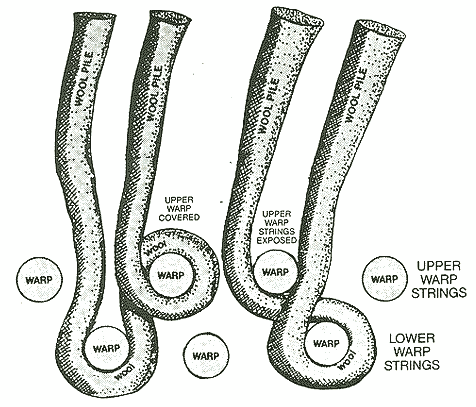 | ||
| OPEN BACK |
CLOSED BACK |
|
The FULL LOOP part of the KNOT is on the UPPER warp thread
| In the
CLOSED BACK KNOT the FULL LOOP is on the LOWER warp thread
| |

DIFFERENT METHODS FOR FINISHING THE UNDERSIDE OF A RUG | ||
Counting Knots Correctly
Counting knots on an oriental rug is easy to learn. Unfortunately most "expert" knot counters do not realize one knot is often counted as two knots and with the use of unplyed strands of yarn, one knot has been mistaken for eight knots or more! We must first learn what one knot looks like from the rug's back.
On the back of a handknotted rug you will see thousands of tiny squarish "bumps" (see below). We must learn the relationship between these "bumps" and the knots. These squarish "bumps" are the visible parts of the knots that loop around the warp threads as shown below.
Every Persian and Turkish knot has two loops but only some rugs show both. Most rugs show only one of the loops. A few rugs show one loop but just part of the other loop.
Before counting knots we must be sure we are counting each knot only once.
RUG KNOTS THAT SHOW TWICE (1 Warp Level)
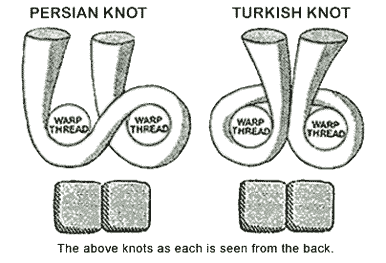 |
WHY TWICE?
When all the warp threads are on the same level, both loops (bumps) show from the back of the rug as shown here.
WHICH RUGS DO THIS?
HOW TO SPOT
|
RUG KNOTS THAT SHOW ONCE (2 Warp Levels)
 |
WHY ONCE?
When there are two layers of warp threads, one of the two knot loops goes "upstairs" and out of view as shown here.
WHICH RUGS?
HOW TO SPOT
|
Amazing But True!
|
HAND TUFTED RUGS
(Also known as Tientsin, Full Cut, or Latex)
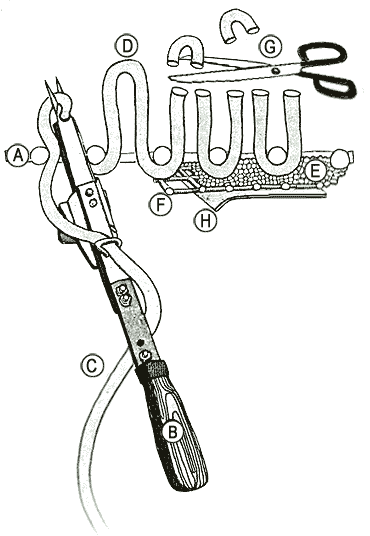 The hand-tufted rug looks and feels very much like a hand-knotted rug. This is because it uses the same fine wool and dyes as the fine knotted rugs use. It differs in the construction method. Instead of tying each knot by hand, the tufted rug is made with a tufting gun (B) from the back of the rug. (Rug hooking is similar but done from the front.) This method saves a lot of time and keeps the price of the rug much lower than a knotted rug of equal size.
CONSTRUCTION STEPS
|
FLAT-WOVEN RUGS
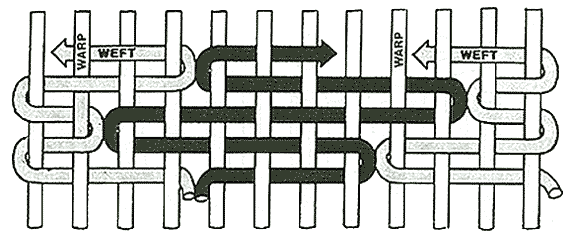
Flat-woven rugs have been made in many area for thousands of years. The designs come from the dyed wefts. There are no knots and therefore no pile. They are generally less expensive and less durable than knotted rugs. Flat-woven rugs are lightweight, easy to handle and normally reversible. A favorite of many decorators.
COMMON METHODS OF CHANGING COLORS

SLIT WEAVE WARP SHARING
(DOVE TAILING) INTERLOCKING WEFTS
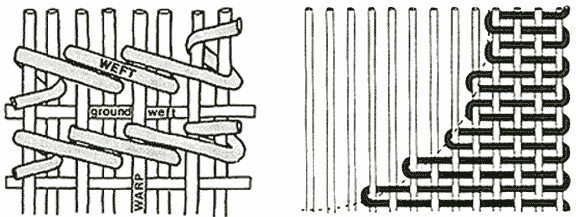
SOUMAK WEAVE
FLAT-WEAVE CIRCLE FORMATION
Quality Grading Systems
China, India and Pakistan each use their own unique system for grading rug quality by knot count. Handmade rugs from any country (except China) are often graded by Knots Per Square Inch, or KPSI - an impotant measure of a hand knotted rug's quality, value and even durability. A rug with a higher knot count will typically possess the attributes of greater intricacy and clarity of design, and is usually more expensive than a rug with a lower knot count, but with similar design features etc.
| Knots Per Square Inch (KPSI) | RUG QUALITY RATING |
|---|---|
| KPSI Corresponds to the Pile Density of Wool | |
| 30 KPSI | Very Coarse |
| 30 - 60 KPSI | Coarse |
| 60 - 130 KPSI | Medium Fine |
| 130 - 160 KPSI | Fine |
| 160 - 290 KPSI | Very Fine |
| 290 + KPSI | Extremely Fine |
By now you should be ready to apply these systems on real rugs! They are not so difficult to learn (a magnifying glass and a ruler may be helpful), but remember - Indian, Chinese, and Persian design Pakistan rugs show each knot only once, but a Pakistan Bokhara rug (for example) shows each knot twice.
|
|
|
|
| 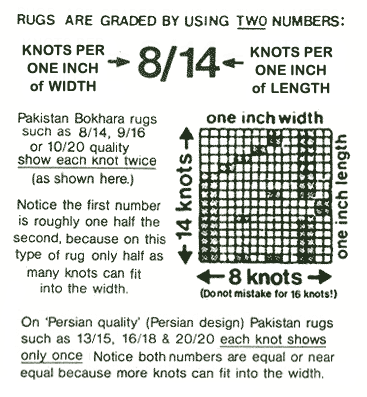 |
|
Rugs from India use a different standard of measure for counting knots for the width: 9/10"; than for the length: 4½" - this relationship represented as a fraction (see above). Knot density in rugs from Pakistan is graded by the square inch using 2 numbers represented as a fraction: the first (top) for width and the second (bottom) for length, respectively. Pakistan Bokhara rugs such as 8/14, 9/16 or 10/20 quality show each knot twice (as shown here). Notice the first number is roughly one half the second, because on this type of rug only half as many knots can fit in the width. On 'Persian quality' (Persian design) Pakistan rugs such as 13/15, 16/18 & 20/20 each knot shows only once (see above). Notice both numbers are equal or near equal because more knots can fit into the width. | |
|
| |
|
All Chinese rugs are graded by "line count". Common line counts include "70 line", "80 line" and "90 line" etc.: | |
|
| |
|
| |
Amazing But True!A Chinese 90 line 9 x 12 rug has more than 10 miles of warp and weft threads in its foundation!
|
© 2007 Nejad Rugs - All rights reserved
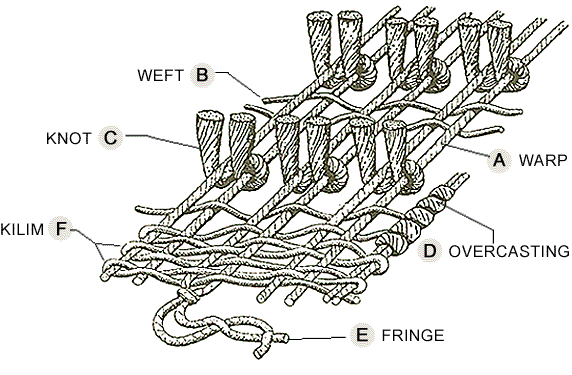
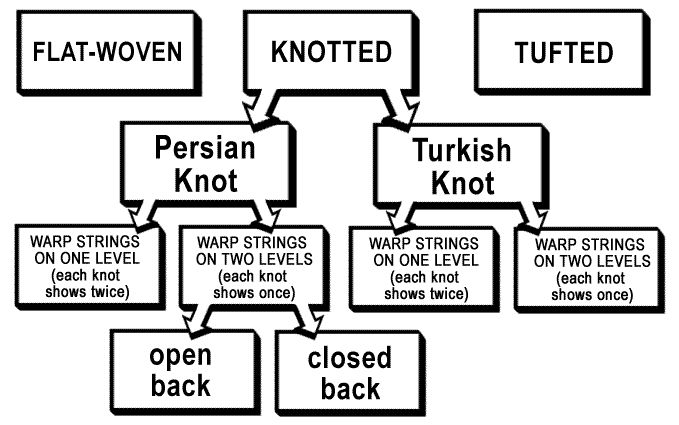
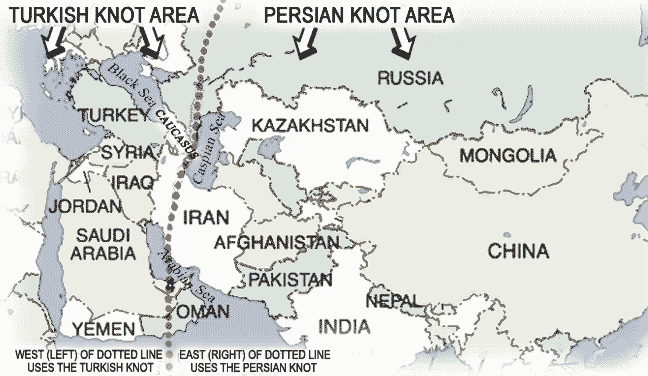
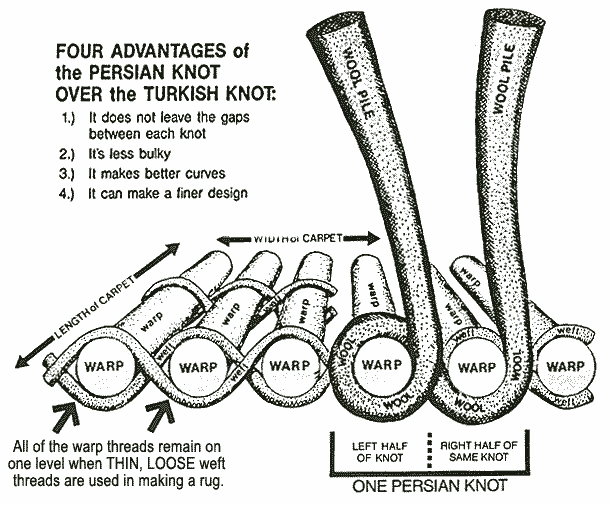
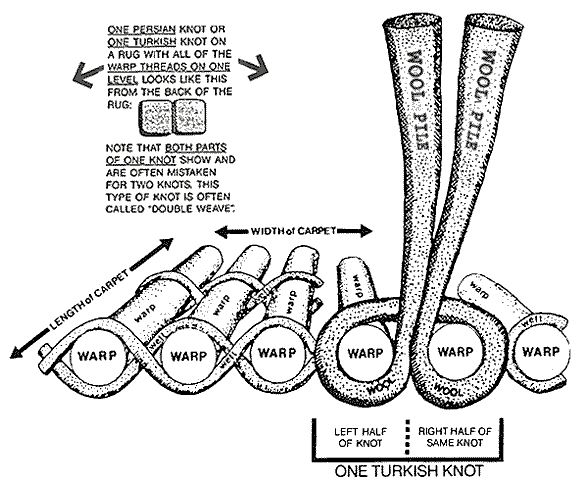

 India
India